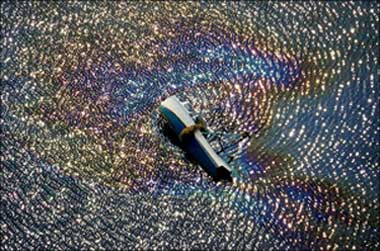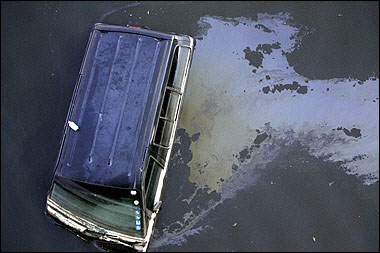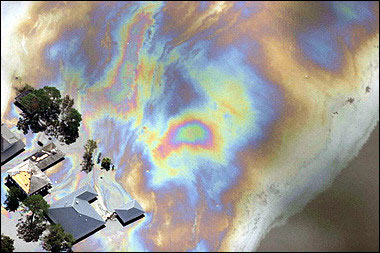Notes
Shimmering to Death



In report after Katrina report, stagnant flood waters have been described as "toxic stew" and "bacterial soup."
Right now, the harm to the environment is plain to see (and smell, and feel). Ultimately, however, its unclear how seriously the media, the public and (partially as a consequence) the state, local and federal government will rigorously tackle the long term ecological and environmental fallout of this disaster.
When it comes to documenting environmental injury, it seems that photojournalists and the media can be too easily lured by beauty and composition at the expense of a more pragmatic visual (as well as investigative) accounting of ecological demise. In my mind, these images serve as a metaphor for our desensitization toward the environment as a health, quality-of-life and, especially, a political issue.
The Bush Administration has been getting away with slow murder on the
environment. The EPA has covered up or glossed over widespread mercury
and lead contamination, as well the toxicity of our seafood. The
complex arrangement devised by the Clinton administration to reduce and
enforce coal emission procedures has been scuttled. There have also
been quiet scandals over outright collusion between industry and the
environmental agency.
Of course, the environmental blow to the Gulf Coast has been profound.
I found passages in at least two articles in yesterday’s NYT to be really terrifying.
In a piece on the recovery challenge (In Reviving New Orleans, A Challenge of Many Tiers – link), Robert D. Bullard, a director of the Environmental Justice Resource Center at Clark Atlanta University stated:
"The fact is that the whole city is now a potential toxic dump or brownfield."
In outlining the problem, the article briefly outlined the scope of
damage, the problem of bureaucratic response, the impact on the poor,
and and even a parallel with the World Trade Center disaster:
Because residues from the floodwaters are likely to contain the high
levels of lead, oil and other toxic substances measured in the water
itself, debates will rage about whether this schoolyard or that park is
safe, much as they did after dust and debris from the World Trade
Center coated Lower Manhattan on Sept. 11, 2001.The federal Environmental Protection Agency has promised to convene
a task force of experts to study the problems in New Orleans. But it
will be weeks, probably months, before many areas are dry enough to
assess.The agency has already found the pathogen E. coli at levels as much
as 20 times what is considered healthy, as well as elevated levels of
lead and suspected carcinogens like PCB’s, said Eryn Witcher, a
spokeswoman for the agency. Ms. Witcher said it was impossible at this
preliminary stage to estimate how much a cleanup would cost or how long
it would take.City officials are assuming that thousands of houses will have to
be bulldozed. "You can’t save a place that’s been soaking for weeks,"
said Robert Kates, an emeritus professor of geography at Brown
University and an expert on disaster recovery.In facing the mess left by Hurricane Katrina, officials responsible
for the environment in New Orleans will contend with a history of
unresolved battles over persistent contamination in poor or black
neighborhoods.
And, if you missed this item, the last part of yesterday’s NYT lead (President Visits as New Orleans Sees Some Gains- link)
reported that the spraying of pesticide to treat contaminated water was
to commence over the city last night. According to the article:
An Air National Guard unit will begin spraying a pesticide over New
Orleans on Monday evening, in an attempt to prevent an outbreak of West
Nile virus and other mosquito-borne illnesses.While the chemical agent that will be used, naled, is believed to
be harmless to humans, officials acknowledged that it was unusual to
spray a pesticide directly over an urban center. Several thousand
residents are believed to remain in New Orleans.Sgt. Shawn David McCowan, a spokesman for the 910th Airlift Wing, a
unit based in Vienna, Ohio, that will be spraying the pesticide, said
people in New Orleans who come into contact with the spray would only
notice a harmless blue dye on their clothing or bodies. The dye is
sprayed with the pesticide to allow the pilots to see what areas they
have covered. The pesticide is commonly used in southern Louisiana.
The fact is, New Orleans is now poisonous. Going forward, the key
questions are: How openly will this fact be acknowledged? How honestly
will the problem be quantified? To what extent will the environment be
restored? To what extent will residents, especially the poor, pay a
physical price (more than before) for a general acquiescence toward
environmental breakdown?
And, how much will the public and the media take a shine to the story as it becomes less visually manifest?
(Caption for the top image from NYT photo series by Vincent Laforet:
"Bleeding gasoline surrounds a boat with shimmering rainbow eddies in
Chalmette, La.")
(image 1: Vincent Laforet/The New York Times. 9/10/05. nyt.com. image 2: Robert Sullivan. Oil
and gas leak from a submerged car beneath an overpass in New
Orleans(AFP/Robert Sullivan. Approximately September 4, 2005.
YahooNews. image 3: Dave Einsel/AFP/Getty Images. A toxic film spreads
over the water near a flooded home in New Orleans, Louisiana.
Approximately September 4, 2005. YahooNews.)


Reactions
Comments Powered by Disqus